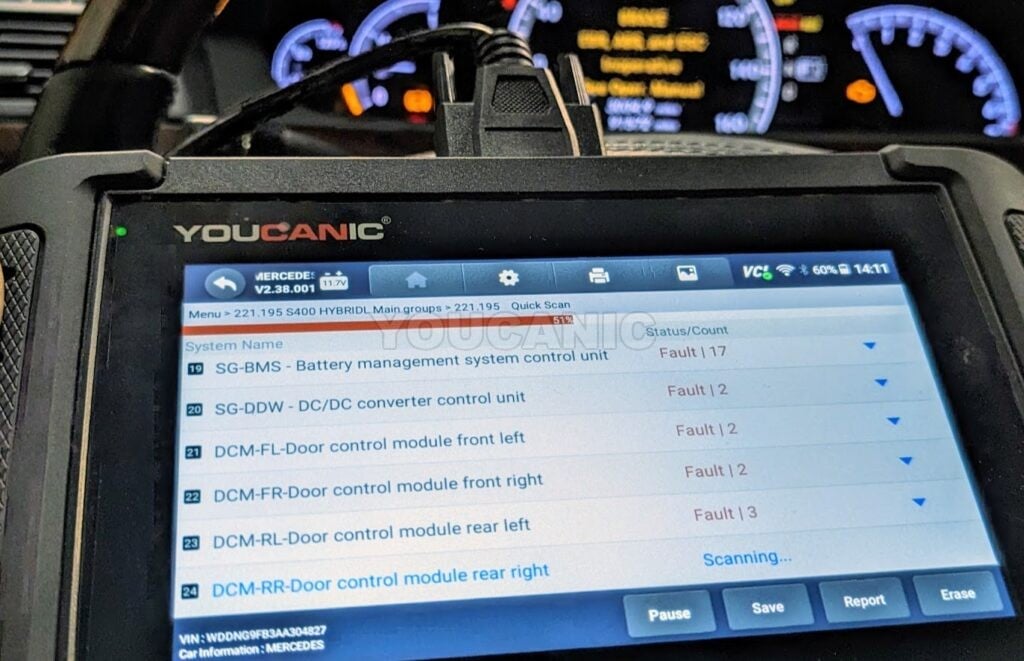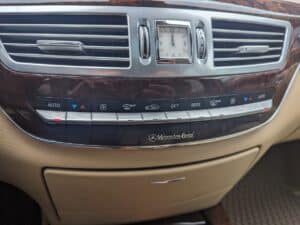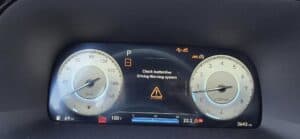Jeep Airbag SRS Light On -Meaning & Problems
Do you own a Jeep, and the airbag light stays on or keeps flashing? Worry not because we’re here to help you fix the problem. In this article, we will explore the common causes and symptoms associated with airbag lights, along with effective troubleshooting techniques and solutions to resolve the problem.
What does the airbag / SRS light mean on a Jeep?


The airbag/srs light means that there’s a system malfunction on the airbags. There are a lot of possible causes which trigger the warning light to come on. It can be a faulty clock spring, bad seat belt pre-tensioner, defective weight sensor, and others, which will be discussed in more detail below. The warning light is an indicator that will alert the driver that there’s a malfunction in the airbag system.
Can You Drive Your Jeep with Airbag Light On?

The airbag/srs light won’t affect the driving condition of your Jeep, but it is not recommended to drive it with the airbag warning light on. The airbag is a safety feature on every vehicle, and it is designed to protect the driver and passengers from a car accident, saving and preventing the occupants from serious injuries. We recommend fixing the airbag light first before driving your vehicle.
If you notice the traction control and ABS lights on simultaneously, it means there is more than one issue with the vehicle. The ABS system is not directly related to the airbag system and should not trigger the airbag light to stay on. Run a vehicle health check with a YOUCANIC scanner to determine what issues are happening with the vehicle.
Troubleshooting Airbag/SRS warning light in a Jeep
Symptoms

When the airbag/SRS (Supplemental Restraint System) light comes on, a range of symptoms can indicate an issue with the system. Here are some common symptoms of a Jeep airbag/SRS light being on:
- Airbag/SRS light on the dashboard: The most obvious symptom of a fault in the airbag/SRS system is a light on the dashboard that indicates an issue with the system.
- Flashing airbag/SRS light: A flashing airbag/SRS light is typically a more serious issue than a steady light and may indicate a fault that may prevent the airbags from deploying in the event of a collision.
- Horn not working: If the airbag/SRS system is faulty, it can also affect the horn’s operation, as it is typically located in the same area as the airbag components.
- Squeaking or clicking noise from the steering wheel: If the airbag/SRS system is faulty, it can also cause a squeaking or clicking noise from the steering wheel, which may indicate a fault in the clock spring or other components.
- Malfunctioning cruise control: A fault in the airbag/SRS system can also affect the operation of the cruise control system, which may not function correctly if there is an issue with the airbag components.
- Steering Buttons Malfunction: A defecting clock spring can trigger the airbag light to illuminate and also affect the steering wheel buttons of your vehicle.
Common Causes

The most common problem that triggers the airbag light to stay on a Jeep vehicle is the failure of the clock spring on the steering wheel column, with faulty passenger occupancy sensors and weak battery also being common issues.
Faulty Occupancy Passenger Sensor

The sensor that detects an individual’s weight in the passenger seat is known as the occupancy passenger sensor. Its job is to inform the airbag control module, which determines whether it should be activated or deactivated. If this sensor has an issue, an airbag scanner can be used for diagnosis. However, before replacing the sensor, it’s crucial to check its wiring. The issue could lie in the wiring rather than the sensor itself.
Deployed Seat Belt Pre-tensioner

The seat belt pre-tensioner is a device that constricts seat belts to lessen the likelihood of passengers colliding with the inside of the car. It tightens the seat belts and is activated in the event of a crash. A pre-tensioner system’s defective sensor or problematic wiring can also trigger it. A malfunctioning airbag control module might cause the pre-tensioner to deploy in certain instances. To know if the seat belt pre-tensioner is bad, you will notice that the seat belt retracts slowly, does not retract, or gets locked sometimes.
Blown Airbag

If your car has been involved in a collision leading to airbag deployment, you’ll notice that the indicator is illuminated. Airbags are designed for one-time use; hence, they must be promptly replaced after deployment. To identify a deployed airbag, you should use an airbag scanning device. This tool will check the entire system and record an error code. This specific code will guide you to the precise location of the airbag due for replacement. After an accident, the airbag or SRS module must be replaced or at least removed and sent for repair to clear the crash data, as this data can’t be cleared with scan tools.
Damaged Wiring

The airbag or supplemental restraint system comprises wiring that links each sensor, control module, and airbag. Various factors, such as aging, exposure to high temperatures, physical harm, and corrosion, can cause these wires to deteriorate over time. Identifying a damaged wire can be challenging without the appropriate tools. To expedite locating the faulty wiring, you should utilize an airbag scanner. This device will navigate the system and alert you to malfunctions with a sensor, airbag, or control module. Following that, you should examine the wiring surrounding the problematic component.
Faulty/Defective Crash Sensors

Crash or impact sensors play a crucial role in alerting the supplemental restraint system (SRS) module when a vehicular accident occurs, initiating the deployment of airbags. Over time, these sensors can deteriorate and may suffer damage due to corrosion. If you suspect a sensor malfunction, using a scanner capable of navigating through the airbag system will be beneficial. This scanner will generate a fault code that indicates a sensor malfunction in your vehicle and provide information regarding its location.
Weak/Dead Battery

A weak primary battery in your vehicle can also affect the airbag system, activating the airbag warning light. A weakened battery may also prompt the illumination of other warning indicators, as certain vehicle components require over 10V voltage for proper operation. To resolve this issue, it is recommended that you promptly replace your battery or, if it’s still viable, allow it to recharge.
Faulty Clock Spring

The clock spring, also known as a circular wire assembly, maintains a stable connection to the airbag and buttons on the steering wheel. Its design is such that it remains undamaged even when the steering wheel is rotated. If the clock spring fail, the airbag warning light will turn on.
While replacing the clock spring isn’t a difficult task, it requires careful and correct installation. Before attending to the steering wheel airbag, disconnect the battery’s negative terminal, wait 15 minutes, and press the horn several times. This drains any residual voltage that could trigger the airbag during removal.
Faulty Airbag Control Module

The airbag/SRS control module monitors the airbag system, including the crash sensors, airbag, weight sensor, tensioner belt, and more. The SRS module is the one that controls the airbags; it can enable/disable the airbags, and it is also the one that manages the airbags when it need to deploy. There are a lot of possible causes why the SRS module fails; examples are water damage, electrical problems, and physical damage due to a car crash. If your vehicle also has a previous accident and airbags have been deployed, you must reset the control module. And for major issues on the SRS module, you will need to replace it.
How to Reset Jeep Airbag / SRS Warning Light?

The airbag light on a Jeep can come on for several reasons, including a dead battery, a faulty sensor, a bad clock spring, etc. To find out, you need to read the codes with a scanner that can read the airbag module, such as YOUCANIC full system scanner. Then fix the underlying issue and clear the codes outlined in the section below.
- Locate the OBD-II port under the dashboard and plug in your adapter.
- Power on the Youcanic scanner: Press the power button until the device turns on.
- Go to the ‘Diagnose’ option: On the scanner’s main menu, select the ‘Diagnose’ option.
- Select the Vehicle Make: You will see a list of vehicle makes. Scroll through the list until you find your vehicle’s make, then select it.
- Select ‘Control Units’: The next screen will display different options after selecting the make.
- Find and select the ‘Control Units’ option.
- Select ‘Airbag/SRS Control Unit’: The next screen will show a list of various control units.
- Scroll down until you select the ‘Airbag/SRS Control Unit’.
- Read or Clear codes: Here, you can ‘Read codes’ or ‘Clear codes.’ To read the airbag codes, select ‘Read codes.’ The scanner will then display any stored airbag codes.
- To clear the airbag codes, select ‘Clear codes.’ Follow any prompts that appear to clear the codes. Please note only clear codes after the problem has been fixed. Clearing the codes without fixing the problem may cause the codes to reappear.
Frequently Asked Questions
What is the Importance of the Airbag Light?
The airbag indicator in a vehicle is an integral safety component. Its function is to notify the driver of any malfunctions within the system, which could potentially prevent the airbags from activating during a collision. Addressing this issue promptly is vital to ensure the safety of those inside the vehicle.
Can I Reset Airbag Light without a Scanner?
While this may be effective on your vehicle, we recommend resetting the issue using a scanner because by using a scanner, you will see what the issue is, and it will be fixed immediately. Also, resetting the airbag light without a scanner will not be effective in the long term.
Can I Reset the Airbag Light by Disconnecting Battery?
No, it is not recommended and will not be effective in the long run. The airbag system can be complicated and should be addressed properly. Also, disconnecting the battery may reset other features saved on your vehicle.
How Much Does it Cost to Fix Jeep Airbag / SRS Light?
The price ranges from around $200 – $2000, depending on the underlying issue. Fixing the airbag light can be simple and complicated for instances like a problem with the airbag control module.
Can a Blown Fuse Cause Airbag to Light On?
Yes. The fuse is an important component because it protects the airbag system. It is the one that prevents the airbag’s electrical system from overloading and short circuits by melting itself.
Does Replacing Jeep’s Clock Spring Triggers Airbag SRS Light?
Yes, if the clock spring was not installed properly or other wirings are not completely connected. Clock springs are sensitive when installing them, so please be careful.
Fault Codes
Here are some common fault codes that can cause the Jeep airbag/SRS light to turn on:
- B1B02 – Driver Airbag Squib 1 Circuit Low
- B1B06 – Driver Airbag Squib 2 Circuit Low
- B1B10 – Driver Airbag Squib 1 Circuit Open
- B1B14 – Driver Airbag Squib 2 Circuit Open
- B1B18 – Driver Airbag Squib 1 Circuit Short to Ground
- B1B1C – Driver Airbag Squib 2 Circuit Short to Ground
- B1B20 – Driver Airbag Squib 1 Circuit Short to Battery or Open
- B1B24 – Driver Airbag Squib 2 Circuit Short to Battery or Open
- B1B40 – Passenger Airbag Squib 1 Circuit Low
- B1B44 – Passenger Airbag Squib 2 Circuit Low
- B1B48 – Passenger Airbag Squib 1 Circuit Open
- B1B4C – Passenger Airbag Squib 2 Circuit Open
- B1B50 – Passenger Airbag Squib 1 Circuit Short to Ground
- B1B54 – Passenger Airbag Squib 2 Circuit Short to Ground
- B1B58 – Passenger Airbag Squib 1 Circuit Short to Battery or Open
- B1B5C – Passenger Airbag Squib 2 Circuit Short to Battery or Open
Applicable Models
All modern Jeep models are equipped with an airbag/SRS module/system, as it is a mandatory safety feature for all vehicles. This includes models such as:
- Jeep Wrangler
- Jeep Grand Cherokee
- Jeep Cherokee
- Jeep Compass
- Jeep Renegade
- Jeep Gladiator
- Jeep Patriot








